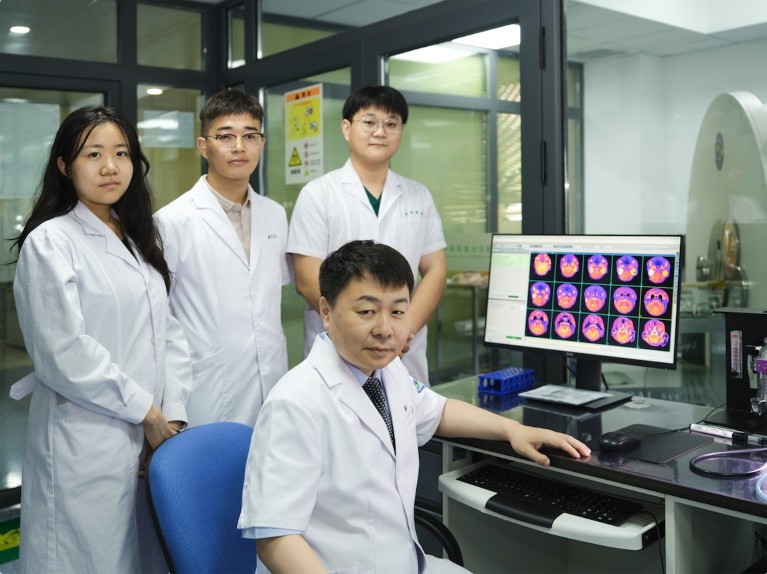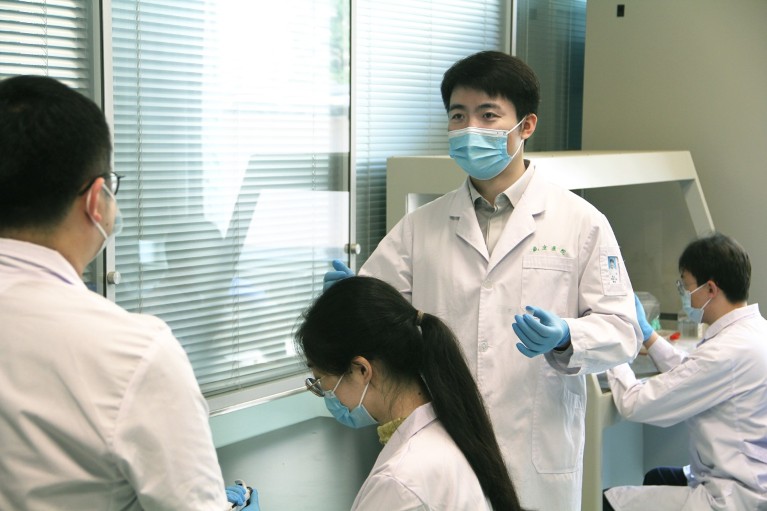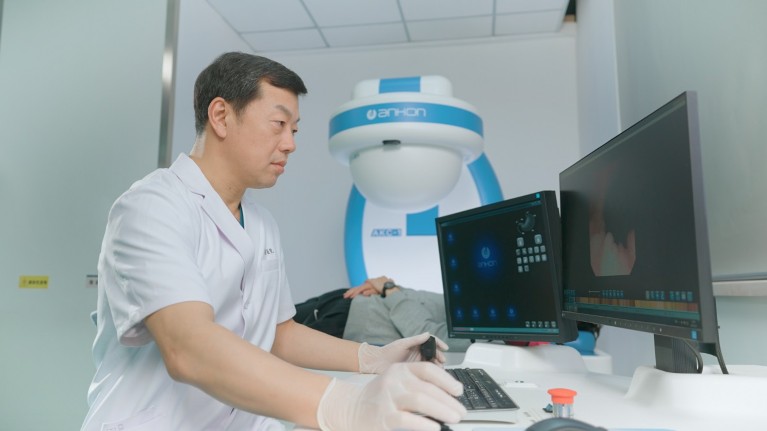Shengjing Hospital makes a conscious effort to bring new medical research into practice.Credit: nicolas_/E+/Getty
Northeast China’s biggest university-affiliated hospital is planning to establish the region’s largest centre for neurological diseases, and success hinges on an ambitious recruitment drive to bring in global researchers. The hospital is also seeking further collaborations with research teams overseas and elevating the role of research in the clinic, including in reproductive medicine and digestive diseases.
The growing centre for neurological diseases at Shengjing Hospital of China Medical University, in Shenyang, Liaoning, is set up to benefit patients and further research.
Take Anhua Wu, the hospital’s vice president and a neurosurgeon, who divides his time between the operating theatre and the laboratory to make it easier to put new medical research into practice.

Anhua Wu(sitting) with his graduate students at the Shengjing Hospital of China Medical University.Credit: Shengjing Hospital of China Medical University
Wu’s team studies the role of a protein, TIM-3, in a particularly aggressive brain tumour, glioblastoma, which has limited treatment options and a median five-year survival rate of less than 10%.
TIM-3 is a checkpoint protein that normally ‘checks’ immune cells, preventing the immune response from becoming so strong that it kills healthy cells. When things go wrong, TIM-3 stops the immune cells from killing cancer cells.
Working in lab dishes, the Wu team identified a chemical feedback loop that involves TIM-3 in the crosstalk between glioblastoma cancer cells and immune cells.
New Strategy
“It suggests a potential immunotherapy strategy,” says Wu, whose results were published in iScience in 20221.
Other neurology research underway at Shengjing Hospital includes investigations of the molecular and cellular mechanisms that underpin nerve damage repair, and how that could improve treatment of progressive neurodegenerative diseases such as Alzheimer’s or Parkinson’s.
Shengjing Hospital researchers also work on brain-computer interfaces (BCIs), which use brain activity to directly operate computers, or even robotic limbs to make human-computer interactions more efficient, or to help people who are paralysed to move.
Another area of research is neuromodulators, chemicals that change how fast nerve cells communicate with one another. They are used to treat pain and mental health disorders.
“These projects are supported by the hospital’s development goal of establishing the largest centre for neurological diseases in northeast China,” says Wu. “A centre that will ultimately improve treatments for patients,” he says.
The benefits to patients of having closer links between research and clinical practice, and across specialities, is also evident at the Shengjing Hospital’s Centre of Reproductive Medicine.
“Our experience treating infertile couples shows that issues raised in the clinic help design better in vitro fertilization strategies,” says Da Li, vice chair of the centre, whose team is using several specialities to understand mechanisms behind sperm quality. They include proteomics, the large-scale study of proteins and their fluctuations during biological processes, and modifier-omics, the large-scale study of chemicals that modify gene activity.
Across specialties

Da Li at the Shengjing Hospital of China Medical University.Credit: Shengjing Hospital of China Medical University
The Li team’s study of 528 couples and a further 25 men, describes fluctuations in 322 sperm proteins associated with factors like sperm motility after short ejaculatory abstinence. The results were published in the journal Molecular & Cellular Proteomics in 20192.
The sharing of knowledge across specialities brings fresh perspectives needed to solve complex diseases, he says.
“Studies in metabolomics have given a new understanding of polycystic ovary syndrome (PCOS) — a very common hormone problem for women of childbearing age,” says Li, “Women with PCOS are also more likely to get gestational diabetes.”
Li’s team papers published in Nature Communications3 and PNAS4 describe a metabolic regulatory network in mice. The network centres on the TET3 protein, a member of the family of proteins that regulate gene activity. The paper suggests TET3, beyond its known role in stem cells and cancer development, also participates in the control of glucose production in the liver, the body’s glucose reservoir.
“Previous studies found a correlation between energy metabolism and fertility,” says Li. He hopes the understanding of TET3 could one day lead to new fertility treatments.
Global health
Shengjing Hospital is also striving to benefit patients around the world by promoting best medical practice and developing genetic databases to support the use of reproductive technology in Asian populations.
Siyu Sun is president of the hospital, head of its digestive disease department, and editor-in-chief of Endoscopic Ultrasound, a journal published by the hospital, and with an editorial board of more than 130 top experts from 30 countries.

Siyu Sun at the Shengjing Hospital of China Medical University.Credit: Shengjing Hospital of China Medical University
“Our hospital is helping researchers develop the next generation of ultrasound and endoscopy devices in China,” says Sun.
Sun’s team is also drafting guidelines on endoscopic ultrasound-guided bile duct and gallbladder drainage. Meanwhile, Li’s team is leading the development standards for non-invasive chromosome screening of embryos, which they hope will be adopted internationally.
All these initiatives are made possible, because Shengjing Hospital provides diverse opportunities and abundant funding for researchers to do cross-disciplinary research, and commercialize medical innovations, says Sun.
“We drive innovation and discovery by integrating clinical and fundamental research,” he says.


